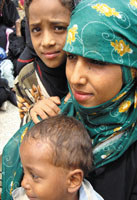Yemen’s 2007 resolution: Beating the odds [Archives:2007/1015/Front Page]
By: Raidan Abdulaziz Al-Saqqaf
SANA'A, Jan. 7 ) During the past decade, the dominant news stories about Yemen in international and regional media have been a litany of its failures; very few stories have been about its successes, probably because those successes continue to be tragically few.
Yemen has been publicized for its dysfunctional government, high levels of corruption, the manifestation of arms and weapons and the world's highest birth rate. Even regarding its successes, such as the recent London donors conference, which raised $5.5 billion to aid Yemeni development, international media commentators continue to refuse the notion that Yemen can succeed: “Yes, Yemen succeeded at the donors conference, but with the emphasis always on those sentences following “but” rather than the statement preceding it.
Yes, the fact is that Yemen is a troubled nation facing numerous obstacles on all fronts, but beating the odds isn't merely a challenge, it's a necessity if Yemen is to develop and advance its society. Yemen's socio-economic problems are difficult to pinpoint, ranging from rural to urban migration and qat's impacts upon the economy to corruption and unemployment.
However, the Yemeni government has formulated a vision for 2025 in order to escape the current poverty and underdevelopment trap and realize the transformation of Yemen into the ranks of those countries with middle human development with a diversified economy and social, scientific, cultural and political progress.
18 more years to 2025
As presented by the Ministry of Planning and International Cooperation, the 2025 vision is based on the assumption that Yemen will achieve an actual economic growth rate of no less than 9 percent annually, beginning with a 2.5 percent increase in per capita production in 2007.
Fifty-four percent of Yemen's labor force works in agriculture, although agriculture accounts for only 17 percent of its gross domestic product, considering that agriculture is a low-value added activity and that 84 percent of agricultural yield constitutes seasonal crops dependant upon rainfall.
Therefore, the 2.5 percent increased per capita production may be possible only via a 5 percent increase in the production of labor involved in non-agricultural economic activities. Thus, the question is: are there any measures being laid out to ensure 5 percent growth in per capita production in 2007?
The answer is yes. According to the 2025 vision's strategic plan, the government is depending on several key sectors to boom in 2007, including rejuvenating coastal regions, accelerating the wheel of industrialization and exploiting potentials in tourism.
Rejuvenating coastal regions
Limited natural resources, topped by a small cultivable area and water scarcity in populous regions, coupled with a continually increasing population – especially in the Central Highlands – highlight some of the chief constraints upon Yemen's economic and social development.
Cities and regions extending along Yemen's approximately 2,000 km. coastline – from the town of Meidi in the north to the town of Hawf (Al-Mahra) in the east – are a strategic component and an essential element for solving this problem on one hand, and accomplishing Yemen's economic and social goals within the next quarter century on the other.
By developing these cities and regions, Yemen can achieve both a population and geographical balance, thus alleviating current urban concentration and migration to urban areas, which already has burdened available services and facilities.
Accelerating the wheel of industrialization
Industrialization and accelerating industrial development should be a strategic option and a determinant in Yemen's economic development over the next period in order to achieve its desired goals and ensure moving from its status as a low-income nation to the ranks of middle income economies with rapid growth by 2025.
Industrial sector goals focus on the need to broaden, improve and diversify the industrial base, improve the quality of industrial products and develop new pioneering industries benefiting from Yemen's comparative advantages in natural resources and labor and which open broad horizons for improving both income and employment.
The ability to “improve the product” by means of a national system for innovation is considered essential to increasing added value, achieving economic diversification and creating new productive job opportunities, in addition to encouraging both small and medium-sized industries.
Similarly, appropriate technology for Yemeni industry must be identified, as well as preparing a strategy to transfer, adopt and produce whatever can be generated locally, especially regarding water desalination, fishing, preserving and marketing fish products, improving seed breeds, irrigation and using fertilizers (biotechnology).
Accelerating industrial development also requires government support and backing in order to establish industrial estates and furnish them with facilities and services, provide land for large industrial projects, which will help reduce high production costs, and improve Yemeni industries' capability and competitiveness.
Exploiting potentials in tourism
Yemen is considered among those countries rich in tourism resources and treasures that have yet to be exploited, which makes it fit to become an important regional nation for tourism.
Developing the tourism sector opens up wide prospects to alleviate unemployment where Yemeni potential allows for developing cultural, historical, environmental, summer, coastal and island tourism, in addition to mountain climbing and desert scouting.
Therefore, in the next period, Yemen will witness a government undertaking to complete several infrastructure projects with diligent activity toward establishing numerous private tourism projects such as hotels, restaurants, tourist villages and complexes, diving centers and tourist transport.
In the event that this promising sector is exploited, tourist numbers will increase from 73,000 in 2000 to an estimated two million in 2025 (via an annual growth rate exceeding the world average), while revenues eventually will reach an estimated $2 to $3 billion.
Experts say that Yemen will have to do far more than it has indicated in order to realize its objective of becoming a nation of middle human development. There are lively examples of how some countries, such as the Asian tigers, achieved economic and development miracles in a few years' time; however, the obstacles Yemen faces are too profound to make achieving its development goals an easy task.
——
[archive-e:1015-v:14-y:2007-d:2007-01-11-p:front]


